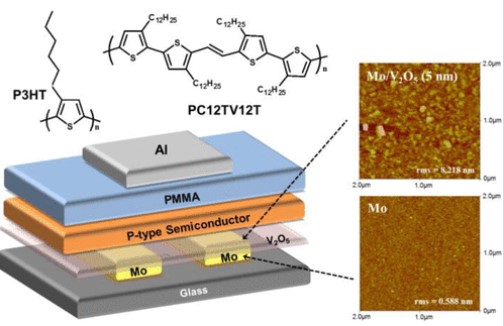Efficient Charge Injection in p-Type Polymer Field-Effect Transistors with Low-Cost Molybdenum Electrodes Through V2O5 Interlayer
- 저자
- Kang-Jun Baeg, Gwang-Tae Bae, and Yong-Young Noh*
- 저널명
- ACS Applied Materials & Interfaces, 5, 12, 5804-5810 (2013)
- 년도
- 2013
- Link
- http://dx.doi.org/10.1021/am401375c 894회 연결
[Abstract]
Here we report high-performance polymer OFETs with a low-cost Mo source/drain electrode by efficient charge injection through the formation of a thermally deposited V2O5 thin film interlayer. A thermally deposited V2O5 interlayer is formed between a regioregular poly(3-hexylthiophene) (rr-P3HT) or a p-type polymer semiconductor containing dodecyl-substituted thienylenevinylene (TV) and dodecylthiophene (PC12TV12T) and the Mo source/drain electrode. The P3HT or PC12TV12T OFETs with the bare Mo electrode exhibited lower charge carrier mobility than those with Au owing to a large barrier height for hole injection (0.5–1.0 eV). By forming the V2O5 layer, the P3HT or PC12TV12T OFETs with V2O5 on the Mo electrode exhibited charge carrier mobility comparable to that of a pristine Au electrode. Best P3HT or PC12TV12T OFETs with 5 nm thick V2O5 on Mo electrode show the charge carrier mobility of 0.12 and 0.38 cm2/(V s), respectively. Ultraviolet photoelectron spectroscopy results exhibited the work-function of the Mo electrode progressively changed from 4.3 to 4.9 eV with an increase in V2O5 thickness from 0 to 5 nm, respectively. Interestingly, the V2O5-deposited Mo exhibits comparable Rc to Au, which mainly results from the decreased barrier height for hole carrier injection from the low-cost metal electrode to the frontier molecular orbital of the p-type polymer semiconductor after the incorporation of the transition metal oxide hole injection layer, such as V2O5. This enables the development of large-area, low-cost electronics with the Mo electrodes and V2O5 interlayer.
